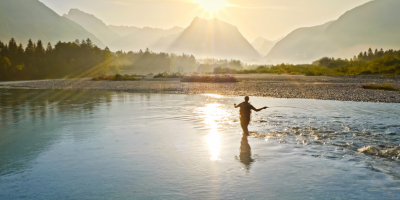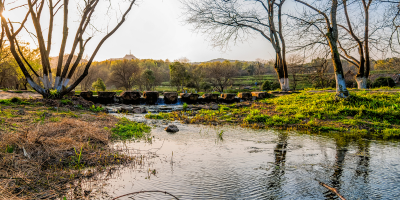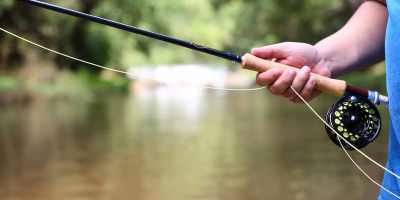Fly fishing is a popular hobby enjoyed by many people around the world. It involves using a lightweight fly rod and reel to cast a special type of lure, known as a fly, into the water to catch fish. Fly fishing can be done in a variety of settings, including rivers, lakes, and streams, and it is a great way to get outdoors and enjoy nature.

For beginners, fly fishing can seem intimidating at first, but with a little bit of practice and patience, anyone can learn how to do it. Understanding the basics of fly fishing, including the equipment needed, the types of flies used, and the techniques for casting and retrieving the fly, is essential for anyone who wants to get started in this exciting hobby.
In this article, we will provide a guide for beginners who are interested in learning more about fly fishing. We will cover the basics of what fly fishing is, the equipment needed to get started, and some frequently asked questions that new fly anglers may have. Whether you are a seasoned angler looking to try something new or a complete beginner, this guide will provide you with the information you need to get started in fly fishing.
Key Takeaways
- Fly fishing is a popular hobby that involves using a lightweight fly rod and reel to catch fish.
- Beginners can learn how to fly fish by understanding the basics of the equipment, types of flies, and casting techniques.
- This guide provides a comprehensive overview of what fly fishing is and how to get started in this exciting hobby.
Understanding Fly Fishing
To kick off this guide here is a video of the basics of fly fishing from Adam. I really like Adams’s fishing adventures on YouTube, he has a great natural style and his videos are packed with tips.
Fly fishing is a type of angling that is done using a specialized fishing rod, reel, line, and artificial fly. This technique is different from traditional fishing methods, as it involves casting a lightweight fly that mimics the natural movement of insects on the water’s surface. Fly fishing is a popular sport worldwide, and it is enjoyed by beginners and experts alike.
Basics of Fly Fishing
Fly fishing requires a few basic components that are essential to the sport. These include a fly rod, reel, line, and artificial fly. The fly rod is typically made of lightweight materials, such as graphite or bamboo, and is designed to cast the fly line. The fly reel is used to hold the fly line and to reel in the fish once it is caught. The fly line is a specialized line that is designed to float on the water’s surface and to cast the fly. The artificial fly is the bait used to catch the fish and is typically made of feathers, fur, or synthetic materials.
Fly Fishing Equipment
Choosing the right fly fishing equipment is essential to the success of your fishing trip. The type of gear you need will depend on the location you plan to fish, the species of fish you want to catch, and the type of fly fishing technique you plan to use. Some of the essential gear you will need includes a fly rod, reel, fly line, leader, tippet, hooks, waders, hat, boots, sunglasses, and a landing net.

Choosing the Right Location
Choosing the right location is essential to the success of your fly fishing trip. You should choose a location that is known for its abundance of fish and that is easily accessible. Some of the best places to go fly fishing include rivers, lakes, and offshore locations. In the UK and Europe, there are many chalkstreams and rivers that are popular for fly fishing.

Species and Bait
Fly fishing can be used to catch a wide range of fish species, including trout, salmon, bass, pike, carp, bonefish, and tuna. The type of bait you use will depend on the species of fish you are trying to catch and the type of fly fishing technique you plan to use. Some of the most popular types of bait include dry flies, nymphs, and streamers.
Understanding the Technique
Fly fishing techniques can vary depending on the location, species of fish, and type of bait being used. Some of the most common techniques include false casting, floating, and sinking. False casting is used to dry the fly and to create a more accurate presentation. Floating is used to keep the fly on the water’s surface, while sinking is used to get the fly deeper into the water.

Safety and Comfort
When fly fishing, it is important to prioritize safety and comfort. This includes wearing appropriate clothing, such as waders and a hat, and using proper equipment, such as sunglasses and a landing net. It is also important to be aware of the weather conditions and to avoid fishing near trees or other obstacles.
Tips for Success
To be successful at fly fishing, it is important to have patience, skill, and knowledge of the sport. Some tips for success include choosing the right location, using the right equipment, and understanding the technique. It is also important to practice casting and to be aware of the fish’s behaviour.
Common Fly Fishing Terms
There are many common terms used in fly fishing, including backing, power, forceps, nippers, float, dry, sink, tapered, intermediate, monofilament, fluorocarbon, and midges. Understanding these terms is essential to the success of your fly fishing trip.
- Leader: A clear, monofilament line attached to the end of the fly line, tapering down in thickness to the point where the fly is tied.
- Tippet: The thinnest part of the leader where the fly is attached; it can be replaced as needed without replacing the entire leader.
- Backing: Line placed on the reel beneath the fly line for extra capacity, important for fighting larger fish.
- Fly: An artificial lure used to mimic insects or baitfish, tied from materials like feathers, fur, and thread.
- Cast: The act of throwing the fly line out onto the water.
- Dry Fly: A type of fly that floats on the water surface, imitating adult insects.
- Wet Fly: A fly that sinks below the water surface, imitating an insect nymph or other underwater prey.
- Nymph: A subsurface fly pattern that imitates the immature form of aquatic insects.
- Streamer: A type of fly designed to imitate small fish or other prey, usually fished below the water surface with movement.
- Hatch: The emergence of aquatic insects from the water, often leading to active feeding by fish.
- Rise: The action of a fish coming to the surface to feed, often visible as a ripple or splash.
- Landing Net: A net used to safely catch and release fish without harm.
- Waders: Waterproof boots extending to the chest, used by anglers to stay dry while standing in water.
- Casting Stroke: The motion made by the angler to lay out the fly line during the cast.
- Loop: The shape formed in the fly line during casting; a tight loop is generally desired for accuracy and distance.
- Strike: The action of the fish taking the fly, and the angler’s response to set the hook.
- Playing: The process of controlling a hooked fish to tire it out for landing.
Different Types of Fish to Catch
Fly fishing can be used to catch a wide range of fish species, including smallmouth bass, redfish, snook, tarpon, panfish, and many others. Each species of fish requires a different type of bait and technique, so it is important to do your research before you go fishing.
In conclusion, fly fishing is a unique and rewarding sport that requires patience, skill, and knowledge. By understanding the basics of fly fishing, choosing the right equipment, and practising the right techniques, you can become a successful fly fisherman.
Frequently Asked Questions
What equipment do I need to start fly fishing?
To start fly fishing, you will need some basic equipment. A fly rod, reel, line, leader, tippet, and flies are the essential items you will need. A wading jacket, waders, and boots are also recommended if you plan to fish in rivers or streams. You can find beginner fly fishing kits that include all of these items at most fly fishing stores.
What are the basic techniques for fly fishing?
The basic techniques for fly fishing include casting, presentation, and reading the water. Casting involves using your fly rod to cast your line and fly onto the water. Presentation refers to how you present your fly to the fish. Reading the water involves understanding the water’s flow, depth, and structure to find where the fish are likely to be.
Where can I find beginner-friendly fly fishing spots in the UK?
There are many beginner-friendly fly fishing spots in the UK, including rivers, streams, and still waters. Some popular spots include the River Test, the River Avon, and Rutland Water. You can also find beginner-friendly fly fishing guides and instructors who can help you find the best spots for your skill level.
What are the differences between fly fishing and regular fishing?
The main difference between fly fishing and regular fishing is the type of gear used. Fly fishing uses a lightweight rod, reel, and line to cast a lightweight fly. Regular fishing uses a heavier rod, reel, and line to cast bait or lures. Fly fishing also requires more technique and skill than regular fishing.
How long does it take to learn fly fishing?
Learning fly fishing can take some time, but with practice, most people can become proficient within a few months. It is important to start with the basics and practice casting and presentation before moving on to more advanced techniques. Taking lessons or hiring a guide can also help speed up the learning process.